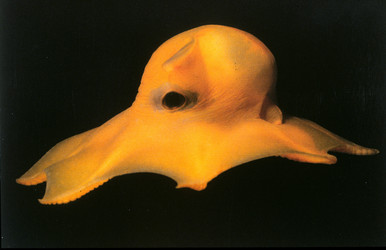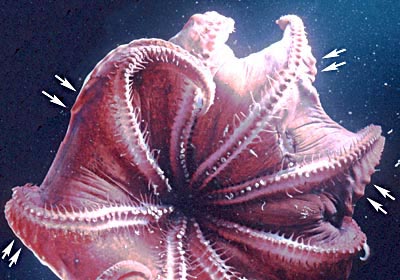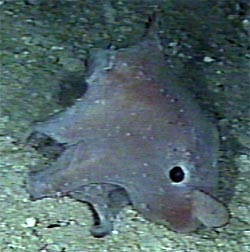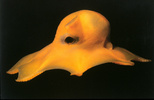Opisthoteuthis
Flapjack devilfishes
Roger Villanueva, Richard E. Young, and Michael Vecchione


This tree diagram shows the relationships between several groups of organisms.
The root of the current tree connects the organisms featured in this tree to their containing group and the rest of the Tree of Life. The basal branching point in the tree represents the ancestor of the other groups in the tree. This ancestor diversified over time into several descendent subgroups, which are represented as internal nodes and terminal taxa to the right.

You can click on the root to travel down the Tree of Life all the way to the root of all Life, and you can click on the names of descendent subgroups to travel up the Tree of Life all the way to individual species.
For more information on ToL tree formatting, please see Interpreting the Tree or Classification. To learn more about phylogenetic trees, please visit our Phylogenetic Biology pages.
close boxIntroduction
Species of Opisthoteuthis are the most compressed, in the anterior-posterior axis, of any cephalopod. This flattened appearance (due sometimes to preservation) gives them the common name of flapjack or pancake devilfish. Fresh specimens have ovoid form. Species are thought to be primarily benthic although they are capable of swimming and in some species the swimming may be an important component of their pouncing on minute prey. As in other cirrates, most species are poorly known.
From Stephanie Bush, "The Opisthoteuthis eggs depicted in this video are preserved specimens, not the eggs laid at the Monterey Bay Aquarium (which are still being lovingly incubated at MBARI's Cold Storage Facility!.)"
Brief diagnosis:
An opisthoteuthid ...- with one or two fields of enlarged suckers on arms of mature males.
- with small fins.
- with areolae present at least in young. (Needs confirmation.)
- with kidney-shaped optic lobe.
- with white body penetrated by two or more separate optic nerve bundles.
- with U-shaped shell.
- without tooth-like structures in sucker aperture.
Full diagnosis of the more restrictive use of the genus (from Collins and Villanueva, 2006):
Moderate-sized cirrates with small, subterminal fins. Shell a flaring U-shape, lateral walls tapering to fine points. Optic nerves pass through white body in two to four bundles. Two fields of enlarged suckers in mature males. Digestive gland entire or bilobed. Radula and posterior salivary glands absent. Web deep, single. Gills of ‘half-orange’ form.*
*Collins and Villanueva (2006) use this same diagnosis to define their family Opisthoteuthidae which contains this single genus.
Characteristics
- Arms and web
- Arms of males generally with modified suckers (i.e., enlarged and often with complex alignment) in one or two fields (proximal and distal).
- Cirri short (in preserved animals).
- Cirri may be retractile into pockets. The retractile (rather than just contractile) nature of the cirri has been suggested by several authors due to their appearance in preserved animals. However, this attribute remains uncertain.
- Web nodules (= web supports; these are often difficult to detect) present as multiple or single nodules or absent.
- Head
- Eyes large, diameter often 60-70% of ML, 50% of head width.
- Two or more bundles of optic tract penetrate white body.
- Optic lobe kidney-shaped in cross-section.
- Beaks: Descriptions can be found here: Lower beak; upper beak.
- Fins
- Small, length approximately half mantle width.
- Small, length approximately half mantle width.
- Shell
- U-shaped, lateral walls (=wings) not parallel (i.e., spread between walls increases toward tips).
- Outer surface of saddle usually with groove (narrow or broad, shallow or deep); outer surface rarely flat.
- Wing frequently terminates as elongate, simple, pointed cone; termination complex in some species.
Although the shell lies at an angle to the body axis, the variation in the angle of the spread of its lateral walls presumably is a measure of the "flatness" (i.e., compression of the anterior-poterior body axis) of the octopod.
The extreme flatness of some Opisthoteuthis is apparent in this video.
- Pigmentation
- Areolar spots present. In some species these are difficult to detect or absent.
- Viscera
- Gills with "half-orange" form.
- Intestine approximately 1.5 - 2.0 times esophagus (and crop) in length. Digestive tract not a simple loop (i.e., intestine makes lateral bends and/or loops.
- Digestive gland bilobed or unilobed.
- Radula absent.
- Gills with "half-orange" form.
Species Comparisons (from Villanueva et al., 2002, Villanueva et al., 2008 and Lu, 2010)
| Mature males | Both sexes | |||||||||||
| Species | Arm I more robust | Prox. field: No. of suckers | Distal field: No. of suckers | Prox. field: Arm no. | Distal field: Arm no. | Distal field: Largest sucker, mean position | DESD> PESD ** | Arm sucker counts | Funnel organ | Web supports | Digest. gland bilobed | Ocean |
|---|---|---|---|---|---|---|---|---|---|---|---|---|
| O. agassizii | No | 5 | 7-8 | I-IV | I-IV | 34-36 | No/yes | 58-80 | V-shape | Multiple | No | W.N.Atlantic |
| O. albatrossi | No | 0 | 3 | None | I | ? | Yes | 80 | ? | Single? | Yes | N. Pacific |
| O. borealis | Slight | 5 | 9-14 | I-IV | I-IV | 27-30 | Equal | 75-82 | ? | No | No | N. Atlantic |
| O. bruuni | No | 3 | 2-3 | I-IV | I-IV | 24-27* | No | ? | 2 pads | ? | ? | E. S. Pacific |
| O. californiana | No | 8-10 | 3-8 | I-IV | I | ca. 27 | Yes | ? | 2 pads | ? | ? | N. Pacific |
| O. calypso | No | 2-6 | 2-3 | III | I-IV | 26-27 | Yes | 47-58 | 2 pads | Single | No | E. Atlantic |
| O. chathamensis | No | 5-7 | 6-8 | I-IV | I-IV | ca 22 | Equal? | 41-55 | V-shape | ? | Yes | W. S. Pacific |
| O. depressa | No | 16 | 0 | I-IV | None | -- | No | 50 | ? | Absent? | ? | W. N. Pacific |
| O. extensa | ? | ? | ? | ? | ? | ? | ? | ? | ? | ? | ? | E. Indian |
| O. grimaldii | No | 4-11 | 9-10 | I-IV | I-IV | 29-31 | No | 73-80 | 2 pads | Single | Yes | E. Atlantic |
| O. hardyi | Slight | 4-9 | 9-14 | I-IV | I-IV | 22-24 | Equal | 60-67 | ? | Absent | No | high S. Atlantic |
| O. japonica | No | 9 | ? | I-IV | ? | -- | No | ? | 2 pads | ? | ? | W.N. Pacific |
| O. massyae | Yes | 7-8 | 9-11 | I-IV | II-IV | 40-41 | No | 81-106 | 2 pads | Multiple | Yes | E. Atlantic |
| O. medusoides | ? | ? | ? | ? | IV | ? | ? | ? | ? | ? | ? | W. Indian |
| O. mero | No | 5-8 | ? | I-IV | None | -- | No | 54-71 | V-shape | ? | Yes | W. S. Pacific |
| O. persephone | No | 3-8 | 4-7 | I-IV | I & II | 31-34 | No | 68-81 | V-shape | Absent | Yes | Off S. Aust. |
| O. philipii | ? | 5-11 | ? | ? | ? | ? | ? | ? | V-shape | Single | ? | NW Indian |
| O. pluto | Yes | 3-6 | 2-4 | I-IV | II-IV | 29-34 | yes male/no female | 59-88 | V-shape | Absent | Yes | Off S. Aust. |
| O. robsoni | No | 7-8 | ? | I-IV | None | -- | No | 74-89 | V-shape | ? | No | W. S. Pacific |
| O. dongshaensis | Yes | 3-4 | 3-4 | I-IV | III & IV | 33-42 | Yes | 74-88 | V-shape | Absent | Yes | N.W. Pacific |
*From illustration. ** DESD = Distal field enlarged sucker diameter; PESD = Proximal field enlarged sucker diameter. For the purposes of this table, a distal field is considered to be absent if suckers there do not show a distinct enlargement.
Nomenclature
Cirroteuthis caudani Joubin, 1896 appears to be a species of Opisthoteuthis [probably O. grimaldii or O. massyae according to Martin Collins, pers. comm., 2002] but the type is apparently lost (Villanueva et al., 2002)
References
Chun, C. 1915. Die Cephalopoden. Myopsida, Octopoda. Wissenschaftliche Ergebnisse der Deutschen Tiefsee-Expedition, "Valdivia" 1898-1899, 18 (2): 405-522 + Atlas.
O'Shea, Steve. 1999. The Marine Fauna of New Zealand: Octopoda (Mollusca: Cephalopoda). NIWA Biodiversity Memoir 112: 280pp.
Sweeney, M.J. 2001. Current Classification of Recent Cephalopoda. pdf file, 59 pp.
Villanueva, R., Collins, M., Sanchez, P. and N. Voss. 2002. Systematics, distribution and biology of the cirrate octopods of the genus Opisthoteuthis (Mollusca, Cephalopoda) in the Atlantic Ocean, with description of two new species. Bulletin of Marine Science 71(2):933-985.
Villanueva R., R.E. Young, M. Vecchione. 2008. Opisthoteuthis Verrill 1883. Flapjack devil shes. Version 28 Apr. 2008 (under construction). Available at http://tolweb.org/Op isthoteuthis/20106/2008.04.28 in The Tree of Life Web Project, http://tolweb.org/.
Voss, G. L. and W. G. Pearcy. 1990. Deep-water octopods (Mollusca: Cephalopoda) of the Northeastern Pacific. Proc. Calif. Acad. Sci. 47: 47-94.
Title Illustrations

| Scientific Name | Opisthoteuthis sp |
|---|---|
| Location | Photographied under aquarium conditions (Monterey Bay Aquarium) |
| Creator | Photo by David Wrobel |
| Specimen Condition | Live Specimen |
| Sex | Female |
| View | lateral |
| Copyright | © Monterey Bay Aquarium |
About This Page
Roger Villanueva

Instituto de Ciencias del Mar (CSIC), Barcelona, Spain
Richard E. Young

University of Hawaii, Honolulu, HI, USA
Michael Vecchione

National Museum of Natural History, Washington, D. C. , USA
Page copyright © 2016 Roger Villanueva , Richard E. Young , and Michael Vecchione
All Rights Reserved.
- First online 13 May 2003
- Content changed 27 February 2016
Citing this page:
Villanueva, Roger, Richard E. Young, and Michael Vecchione. 2016. Opisthoteuthis . Flapjack devilfishes. Version 27 February 2016 (under construction). http://tolweb.org/Opisthoteuthis/20106/2016.02.27 in The Tree of Life Web Project, http://tolweb.org/









 Go to quick links
Go to quick search
Go to navigation for this section of the ToL site
Go to detailed links for the ToL site
Go to quick links
Go to quick search
Go to navigation for this section of the ToL site
Go to detailed links for the ToL site